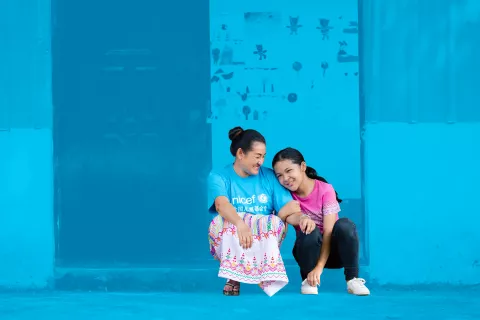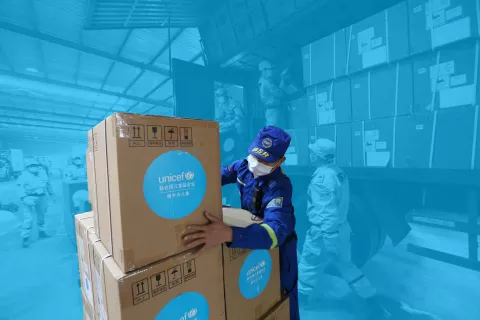Child Health and Development
Ensuring infants, children and adolescents survive, thrive, and achieve their developmental potential.

- Available in:
- 中文
- English
Challenges
China has made remarkable progress in the past 30 years in improving child and maternal health. However, there is still work to be done to achieve the Sustainable Development Goals and China’s Healthy China 2030 Action Plan.
The major challenges UNICEF, the Government of China, and partners are working together to solve are:
| Infant and young child mortality |
There are still challenges to reducing newborn deaths in China. There are around 92,000 stillbirths, and 73,000 newborn deaths per year, which account for about 50 per cent of deaths among children under 5. Poor maternal nutrition is a contributor to maternal complications and stillbirths. Although remarkable progress has been made in preventing mother-to-child transmission of HIV, syphilis and hepatitis B, it has not been eliminated. |
| Injuries and accidents |
Unintentional injuries are a leading cause of death in children from 1 to 17 years old. There are around 10 million children injured each year, and over 60,000 die from these injuries. Among these deaths, over 21,000 are caused by drowning. |
|
Infant and young child feeding |
The exclusive breastfeeding rate of infants under 6 months old is just 21 per cent, and the diets of more than half of children under 2 years old do not meet minimum standards. |
|
Childhood overweight and obesity |
Child overweight and obesity rates have grown rapidly over the past decades. In 2015 it was reported that there were over 15 million obese children aged 2-19 in China. Many children are not growing up in a healthy food environment. |
| Delays in Early Childhood Development |
Nearly 17 million children under 5 years old are unable to reach their full potential, and are at risk of early developmental delays and disability. Children - particularly in rural areas - remain at risk of not reaching their full potential due to relative poverty, malnutrition, lack of stimulation, parenting practices and insufficient support. As a result, more than one third of children under 3 years old are at risk of developmental delays in poorer rural areas. |
| Adolescent mental health |
There is work to be done to include adolescents in the formulation of China’s health policy. More than 30 million children and adolescents under 17 years have behavioural and emotional problems, of which over 50 per cent may need but are not receiving mental health services. |
| Universal health coverage, and retaining affordable maternal and child health | 95 per cent of the population is covered by basic medical insurance, but several routine child health services – especially those that are preventative – are out-of-pocket expenses. |
| Sanitation and hygiene |
Sanitation still needs improvement so that it meets the SDG standards for the entire population. Some major bottlenecks include a lack of standards and indicators aligned with the SDG framework, weak monitoring of WASH data, unimproved sanitation in some rural areas, and existing cultural and social norms around sanitation. |
| Environmental pollution | China’s rapid economic development has come at a cost, with new challenges to the living and natural environment including pollution and the degradation of water, soil and air, which all affect people’s health. There is a need for greater public awareness of air pollution – both outdoor and indoor. |
Solutions
Together with the Government of China and partners, UNICEF will prioritize unfinished business around reducing preventable deaths, strengthening early childhood development services, and addressing new and emerging public health threats that children face in China.
This work includes:
| Improving poor and inequitable quality of care around the time of birth |
Scaling up the quality Early Essential Newborn Care services to improve birth outcomes in maternity facilities for all children, including skin-to-skin contact, neonatal resuscitation, delayed cord clamping, early initiation of breastfeeding, and kangaroo mother care, as well as special care for premature, low-birth-weight and sick newborns. |
| Promoting maternal nutrition in health facilities |
Accelerating the improvement of antenatal care, and making comprehensive maternal nutrition services available to all mothers and mothers-to-be through advocacy, standards and guideline development, quality insurance, data and information system improvement, and communication for development. |
| Eliminating mother-to-child transmission of HIV, syphilis and hepatitis B (EMTCT) | Supporting the Government of China to develop a National Plan of Action on EMTCT, to scale-up experiences generated from the 2016-2020 UNICEF-supported EMTCT project across the country, and prepare for the validation of triple EMTCT by 2025. |
| Preventing child death, disability and injuries related to accidents | Promoting legislation and enforcement on road safety and child safety with government counterparts and key stakeholders. UNICEF will support the development of a National Action Plan for Child Injury Prevention, improve capacities on data reporting and analysis of injuries and deaths from accidents, advocate for multi-sectoral mechanisms centred around the principles of ‘safe communities, safe schools, and safe homes’, support capacity building for government agencies at all levels, and conduct interventions on prioritized injuries including road traffic injury and drowning. |
| Expanding access to early childhood development | Focusing on children in rural areas and enhancing parents’ and caregivers’ knowledge and skills in nurturing care, as well as strengthening early detection of development delays, and supporting families. |
| Promoting infant and young child nutrition | Increasing the rate of exclusive breastfeeding under 6 months and appropriate complementary feeding by strengthening the capacity of health workers in infant and young child feeding counselling. Advocating for the reinstatement of regulations relating to the marketing of breast milk substitutes. |
| Advocating Family-Friendly Policies | Encouraging employers to adopt family-friendly policies to meet the needs of working parents relating to early childhood feeding and development. |
| Preventing and reducing child and adolescent overweight | Strengthening labelling and marketing regulations, and promoting among caregivers and other consumers the importance of a healthy diet. This will include school-based interventions and urban-based interventions to improve the food environment for children. |
| Improving adolescent health, especially mental health | Promoting the expansion of programmes that support adolescents to cope with stress related to school and relationships through school-based or online interventions, or using peer support. |
| Increasing sanitation access and improving environmental health | Focusing on groups and areas where children are exposed to unsafe, unhygienic and polluted environments. This includes unsafe sanitation at home, in schools and health care facilities, and polluted air that affects child survival, growth and development. |
| South-South Cooperation (SSC) |
UNICEF is increasing the capacity of our partners to deliver quality training programmes in countries towards achieving Sustainable Development Goals relating to maternal and newborn health. We are also strengthening collaboration among in-country agencies and projects to better implement South-South Cooperation programmes that relate to maternal and newborn health. |
Resources
These resources on education represent just a small selection of materials produced by UNICEF and its partners in the last two years. The list is regularly updated to include the latest information.





